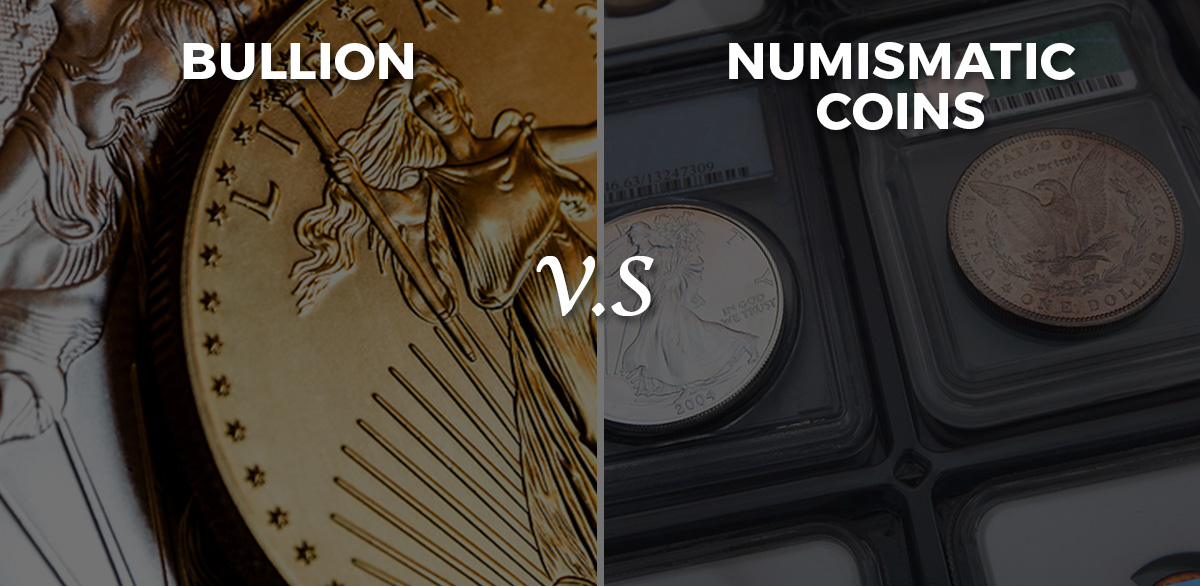 Gold has long been revered as a symbol of wealth and stability, making it a popular choice for investors looking to diversify their portfolios and hedge against economic uncertainties. Investors have turned to this precious metal for centuries to shore up their wealth from the volatility and instability of traditional markets.
Gold has long been revered as a symbol of wealth and stability, making it a popular choice for investors looking to diversify their portfolios and hedge against economic uncertainties. Investors have turned to this precious metal for centuries to shore up their wealth from the volatility and instability of traditional markets.
Newcomers to the physical metals market might be wondering whether gold coins or bars are the better option. These popular assets offer a direct investment in tangible gold yet each comes with specific advantages and considerations. Understanding where gold coins and bars overlap and where they differ can make it easier for investors to choose the best option for their portfolios.
Bullion vs Numismatic – A Unique Distinction for Gold Coins vs Bars

Before we dive in, we need to point out a key difference when it comes to gold coin investing, and that is the difference between bullion and numismatic gold coins. It is a unique distinction for gold coins that is not a consideration with gold bars. Bullion coins are primarily purchased for their metal content and are seen as a straightforward way to invest in gold, offering a direct correlation to the market price of gold. Numismatic coins, however, are valued for their rarity, historical significance, and condition, often commanding premiums well above their intrinsic gold value. This fundamental distinction impacts everything from potential returns to market volatility and the level of expertise required for making informed investment decisions.
👉 Suggested read: Bullion vs. Numismatic Coins: What You Should Know Before Investing
Gold Coins vs Gold Bars – Investing Considerations
Purity
Purity – the amount of pure gold in an asset – is one of the most pressing considerations when choosing gold investments. Both gold bars and gold coins boast impressive purity ratings, underscoring their popularity among investors. However, the fineness of these assets isn’t a complete wash.
On average, gold bars have a higher purity rating than gold coins. Gold bars are designed and minted for a single purpose: investing. As a result, their gold contents tend to be as high as possible, usually between 99.5% and 99.99%. Most modern bars lean toward .9999 fineness due to the advancements in minting.
On the other hand, gold coins are produced for various reasons including investment, legal tender, and collectibles. This range of purposes is reflected in a broader range of purity which hovers between 90% and 99.99%.
Dealer Premiums
Investors have to pay dealer premiums on all precious metals assets, including gold coins and bars. These industry-standard add-ons account for the handling, transportation, storage, and other overhead costs incurred by dealers. Although these premiums can’t be avoided, they’re not uniform across all physical gold assets.
Gold bars tend to have lower premiums because of their lower production costs, standardized shapes, larger unit sizes, and lack of intricate designs. Conversely, gold coins attract higher dealer premiums due to their involved minting processes, artistic and complex designs, and limited production rates.
Liquidity
Gold coins and bars are regarded as highly liquid assets, especially given their tangible nature. As the most actively traded precious metal, gold enjoys near-universal recognition, worldwide use, and consistent demand regardless of economic conditions. Whenever investors seek to convert their gold assets to cash, the process is usually quick, seamless, and simple.
Since gold bars are only evaluated based on their gold contents, it’s generally easier for buyers and sellers to determine a price. The additional numismatic considerations that can come with gold coins – such as condition, historical significance, and scarcity – can add value considerations to the transaction process.
Flexibility
When it comes to investment flexibility, gold coins outshine their bar counterparts. Gold coins come in a greater variety of fractional sizes (anything lighter than 1 oz), including 1/10, 1/20, and 1/40 oz coins. These smaller iterations allow investors to add or remove gold from their portfolio in smaller increments, resulting in greater agility.
On the flip side, gold bars tend to come in larger sizes, weighing anywhere between the standard 1 oz up to 400 oz. The smallest gold bars available clock in at 1/10 oz which certainly allows for flexibility, but not as much as gold coins. Whether you want to buy or sell a small amount of your holdings, gold bars can leave you stuck since they can’t be broken down.
Growth Potential
Gold coins and bars are primarily sought out for their ability to preserve wealth in periods of economic weakness. However, both of these precious metals assets have significant growth potential too. Their high gold content, which closely follow the spot price of gold, confer impressive evaluations given this yellow metal’s steady growth over the past decades.
👉 Related read: Gold Price Forecasts 2025
While gold bars and bullion coins only draw value based on their purity, numismatic gold coins have the potential for growth beyond this point. Their numismatic appeal offers add-on value based on historical significance, condition, and scarcity. In some cases, these factors can skyrocket a gold coin’s pricing multiples beyond its melt value. This isn’t true for most gold bullion coins.
IRA Eligibility
Through a precious metals IRA, investors can make gold coins and bars part of their diversified nest eggs. The IRS permits the investment of tax-advantaged dollars into these physical gold assets, so long as they meet a set of strict eligibility requirements, including:
| Gold Coins | Gold Bars | |
|---|---|---|
| Purity Rating | 99.5% (except for American Gold Eagles which have 91.67% purity) | 99.5% |
| Size | 1/10, 1/4, 1/2, 1 oz | Up to 400 oz in exact weight specifications |
| Manufacturers | Government mints (domestic and foreign) | Government mints and recognized private mints |
Given the greater variety of gold coins, a larger percentage of these assets won’t meet these high standards compared to gold bars. The uniformity and investment focus of bars means most are eligible.
Storage
On a practical level, bars make for easier storage due to their uniform, rectangular shape which better facilitates stacking. Furthermore, their larger sizes can allow for the efficient storage of substantial amounts of gold in compact form.
Wear and tear is another important storage consideration. Since most gold bars are only worth their melt value, investors don’t have to worry about minor damage incurred from units coming into contact with each other. This isn’t the case for many gold coins (especially numismatic coins) which derive value beyond gold contents. The condition of these coins can boost their evaluations which becomes a crucial consideration when looking for secure storage options.
Gold Coins vs Bars: Which should you buy?
When comparing the merits of gold coins and gold bars, investors should take their unique circumstances into account. The most appropriate investment depends on a variety of personal factors including your goals, budget, timeline, risk tolerance, preferences, and current portfolio allocation.
Learn More About Investing in Gold
If you’re interested in learning more about the nuances between gold coins and bars and other physical metals assets, grab a FREE copy of our Precious Metals Investment Guide. It covers everything you need to know about diversifying your portfolio and protecting your wealth with these tangible assets.


